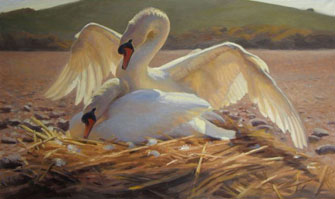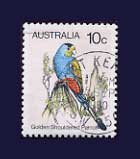Animal care and behaviour:
Birdwatching in Spain
Click on the swans to get to the website of this artist.
See also:
Birdwatching in the Wild West of Spain
Drive out west from Madrid towards Portugal, and, after an hour or so, when the high rise suburbs have receded, you can see a mountain range to your right, running almost parallel to the road. The peaks come closer to the motorway after you get past Talavera, and can be snow covered as late as June, providing a cool contrast.to the shimmering heat of the plains below. Near Oropesa, with its castle, perched on a hill to the left. To the right, there are signs for roads leading to Candeleda and Madrigal, villages on the foothills of the Gredos mountains. This is prime birdwatching country.
There is such a wide range of habitat, mountains, rivers and plains, in a small area, that you can see a surprising range of birds. In the towns and villages, wherever there's a high building, storks build untidy nests, and make majestic forays from rooftops. Go a few miles straight down the motorway to Calzada or, a little further along to El Gordo, and you can see two villages that seem to be populated mainly by storks. Calzada was once a bustling textile town, but the industry collapsed, and people migrated to the cities, leaving only a few hundred inhabitants, a convent, and a dilapidated church, the roof of which is home to a multitude of storks. El Gordo is also a quiet place. Much of the surrounding area was drowned when the Valdecañas reservoir was built. An old Roman town nearby, Talavera la Vieja, completely disappeared. This flooding was unfortunate for people whose houses disappeared, and who had to emigrate, but was a boon for water birds which populate the reservoir, which is also a good spot for bathing.
Calzada is the bigger of the two villages, and has more storks, though El Gordo is closer to the reservoir. Chat to locals in the bars off Calzada main square, and you will find out why. Tourists love to watch the storks, but their nests weigh a lot, and the sheer weight can damage roofs. Sometimes the owners of the buildings have a clear-out, but the birds often just rebuild their nests. There are special structures for storks to build their nests on, allowing the birds to stay, and the roofs to remain intact, though most of the nests are still on the top of large buildings.
You can turn left off the motorway, rather than going straight on to El Gordo, and travel through Oropesa, to go south to Puente del Arzobispo ('Bridge of the Archbishop'), named after the old stone bridge over the river Tagus, underneath which there is a large swift colony. You can stand on the bridge and watch the swifts dart past as they catch insects over the river. Puente del Arzobispo is a pottery town. The red clay from the Tagus, under the bridge where the swifts live, is used in the local industry. Many houses have a family kiln, with pottery wares on display outside the front door.
Back at the Oropesa junction, instead of turning left, you can turn right off the motorway, and move north along the Candeleda road, towards the Gredos mountain range. One attraction of this route is the abundance of birds of prey, sometimes in unexpected places. The Oropesa rubbish tip, just a little way along the Candeleda road, is a great attraction for many noble birds!
The towns and villages in this region are varied, each with its own peculiar character. Lagartera, straight ahead on the motorway, just past Oropesa, and just off the main road, specialises in embroideries and pig rearing. You can still see women sitting on low straw-seated chairs, making drawn threadwork tablecloths by the old church, with its obligatory storks. Lagartera is a lively little town at night, with a lot of good bars.. Lagartera has a comfortable Casa Rural, El Sosiego, a modernised traditional village house which offers self-catering accommodation. Local people note that the local storks migrate less than in the past, perhaps because these days they have rubbish tips to feed from. In the old days, just after the Civil War, people often went hungry, and little that was edible was thrown out. Today humans have a surfeit of food, and this helps to sustain local wildlife, even if the rubbish tips are visually unappealing.
The older houses in these plains towns and villages tend to be built of granite, Move north, from Oropesa, to the foothills of the Gredos mountains, and the building style changes dramatically. Many streets are narrow, with a stream running through the middle, and tall, wood-framed houses with mud packed walls on each side of the street. They look like old Elizabethan houses, you can almost shake hands across the street from the top floors. This region is called the Vera, and most of the towns' names end in 'de la Vera'. Valverde de la Vera and Villanueva de la Vera have some of the best preserved buildings, while Jaradilla boasts a castle parador.
There is a particularly benign microclimate in the Vera towns, which means that they are not as cold in winter, or as stiflingly hot in summer as the towns on the plain forays high into the Gredos mountains, or for trips down to the plain. One word of warning though, while the plains can be stiflingly hot in summer, be prepared for it to get very cold indeed if you travel high up the mountains in the winter. The winds at the top of the Gredos mountains can be bitingly cold, yet it's worth the discomfort for the spectacular views. There are a number of tracks which criss-cross the Gredos, some very ancient, used by the Moors before the Reconquest, and no doubt used by the Romans, several centuries before them. There is a magical feeling when you rest by the side of a track, listening to a concert of goat bells in the distance.
A stick of bread, a hunk of sheep's cheese, and some tomatoes can be very welcome on a birdwatching hike. The local food tends to be of the robust, peasant variety, very tasty with strong flavours. The Vera is a region where vegetables thrive, so food tends to be healthier than in the plains, where dishes are more likely to consist of meat and ballast.
Vegetarians are often looked at pityingly all through this region, and may find they are offered yet another omelette, so they might consider self-catering! There are good ranges of pulses and cheeses in the local supermarkets, though lentil and chickpea dishes in restaurants tend to be served with meat. The local food, like much Spanish food, is also sometimes a little salty for the English palate, so self-catering has another advantage of allowing you to reduce your salt intake!
How can you travel round the area if you don't want to take your car? There are very cheap bus services from Madrid to Oropesa and Lagartera, if you want to stay on the plains, and it's easier to cycle along the flatter land than up un the mountains! Bus services also go from Madrid to the Vera pueblos, though they are less frequent than to the plains, and the journey takes much longer. You can also catch a train to Navalmoral, where it's possible to hire a car. Local taxis are quite cheap by British standards, so you may find it worth while to hire a taxi for an afternoon, or even a day trip.
Visitors who are lucky enough to stay for a long period in this region can plan long trips, for example to Guadaloupe to the south, with its monastery, now Catholic, but with obvious Moorish influences in the architecture. Salamanca, to the north, is also a spectacularly beautiful town, with its cathedral and university. Further west, there's Plasencia, where storks nest in a large colony just off the main square. Or you can travel further west, to the Monfrague nature reserve, or to the Las Hurdes region. Las Hurdes was once a synonym of rural poverty and backwardness, but is now more prosperous, with picturesque villages, and rough tracks across wild terrain, where you can pause to watch the bird life.
It's well worth a trip to the wild west of Spain, to experience a secret Spain that few British people know. The breathtaking views, the hospitality, the food, and, of course, the birds.
For information on El Sosiego: http://www.elsosiego.es/
For Birds on Stamps: http://www.filatelicbird.co.uk/birds1.html




